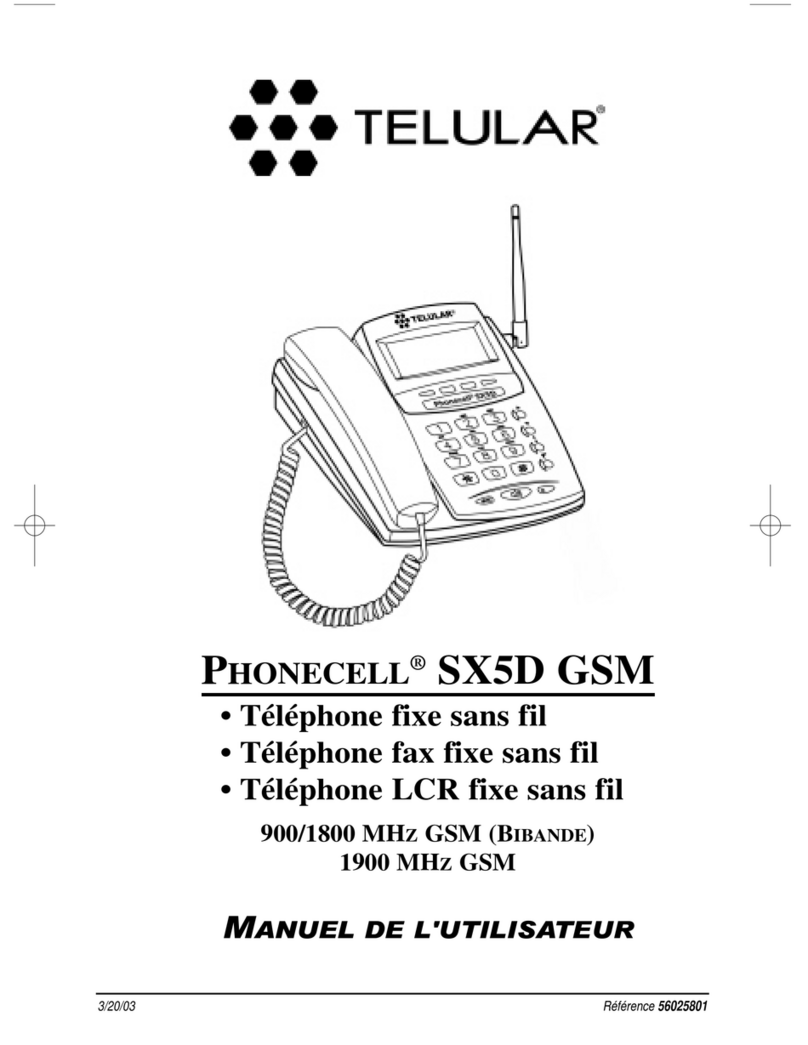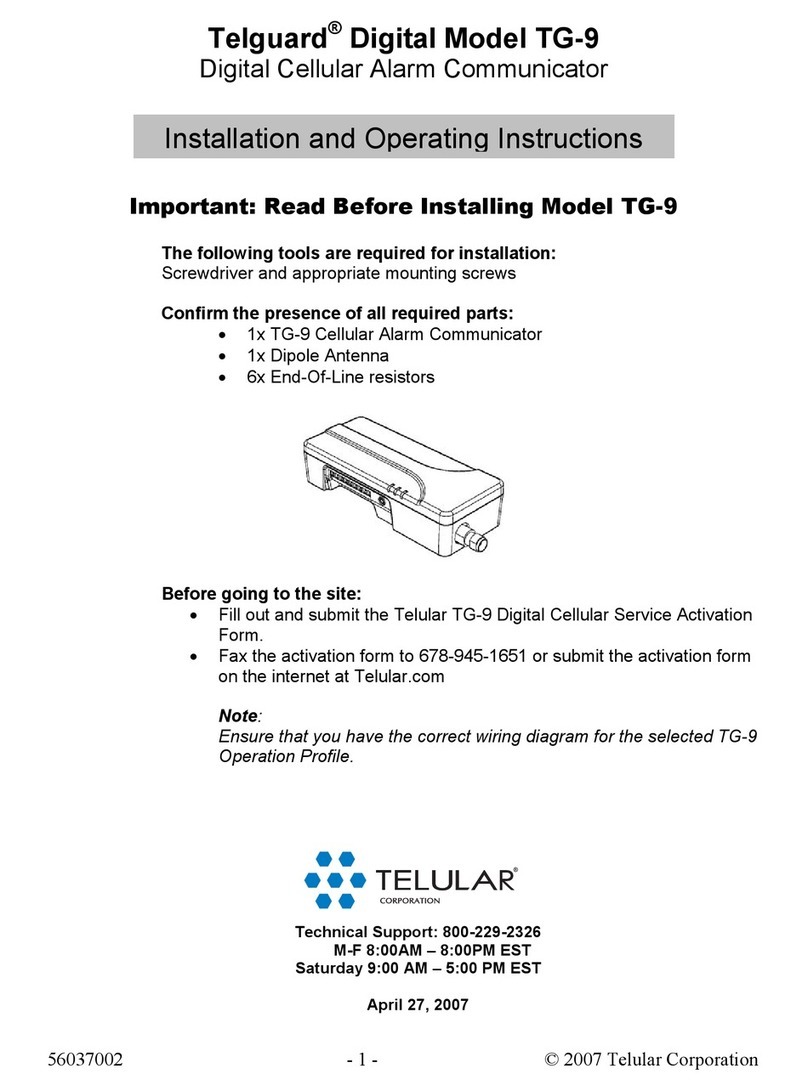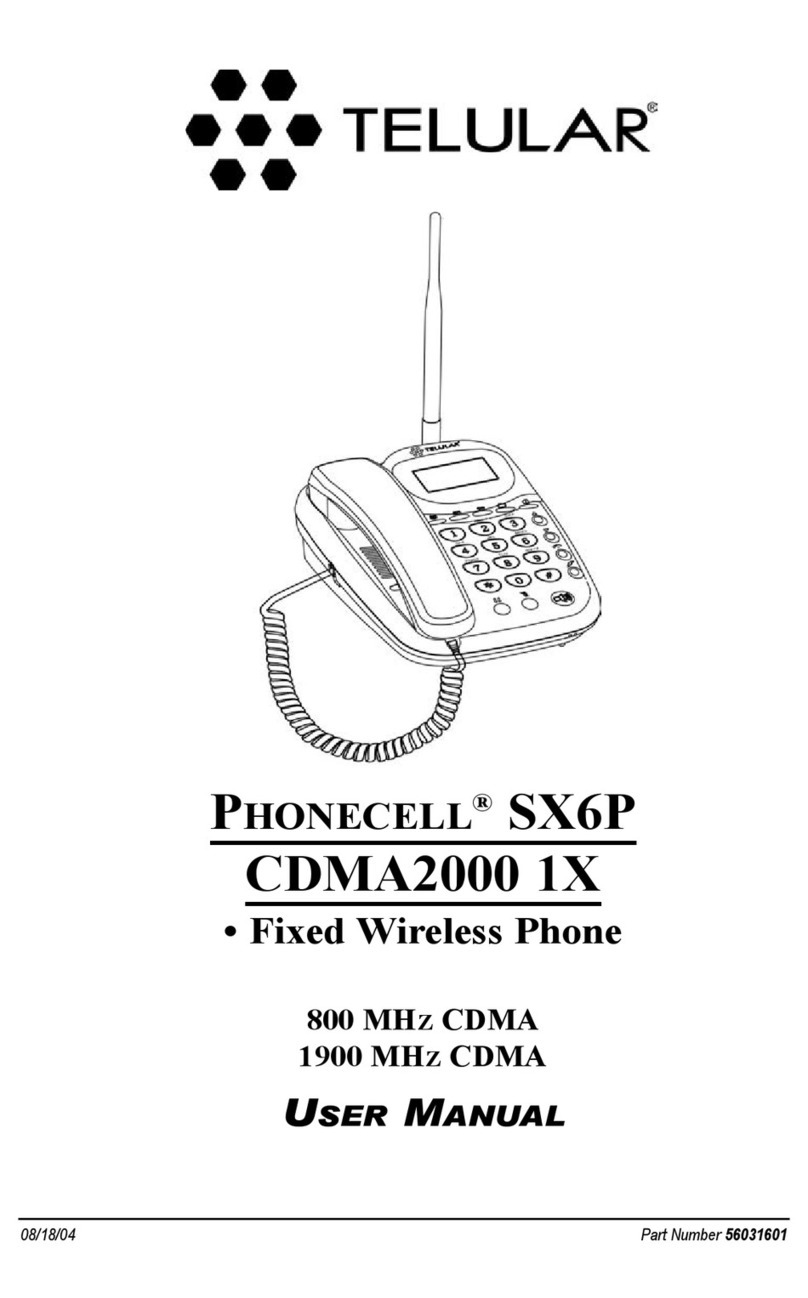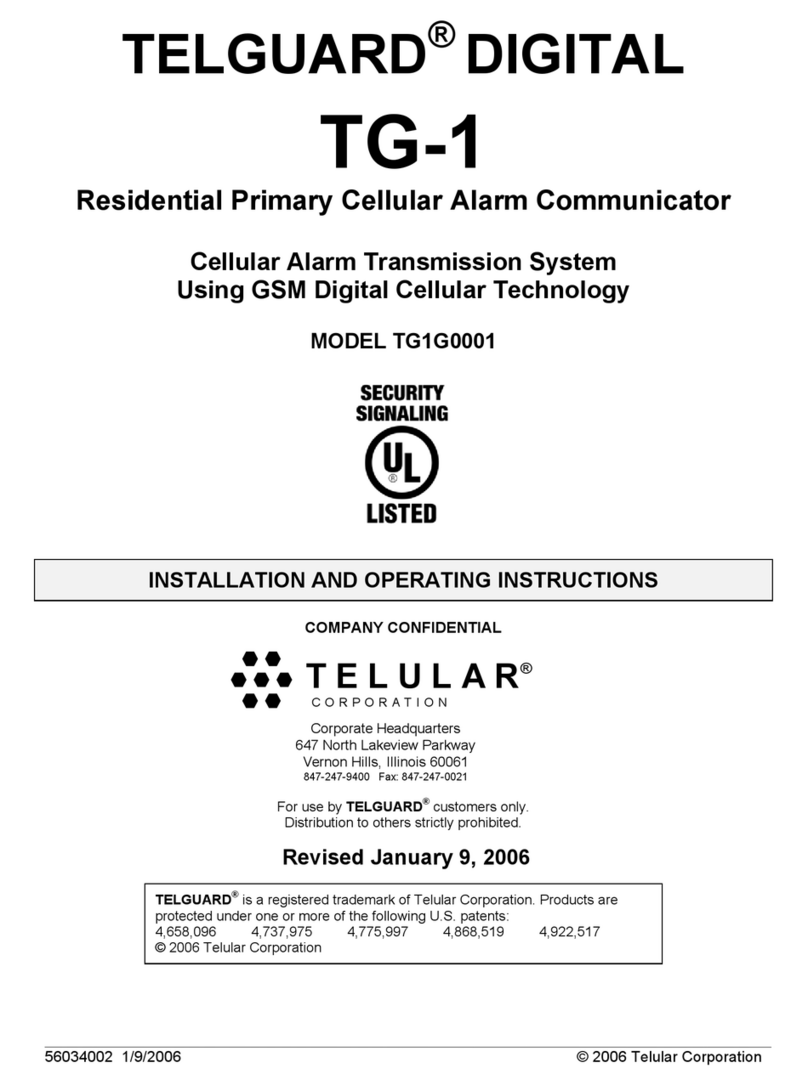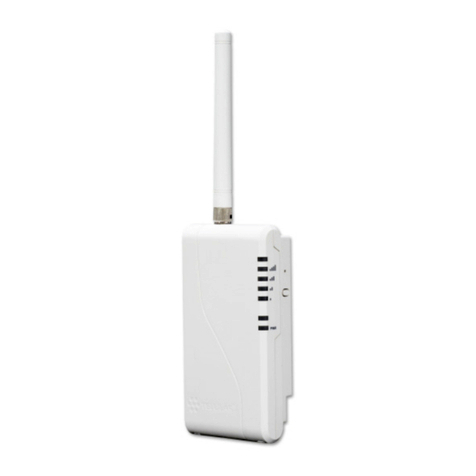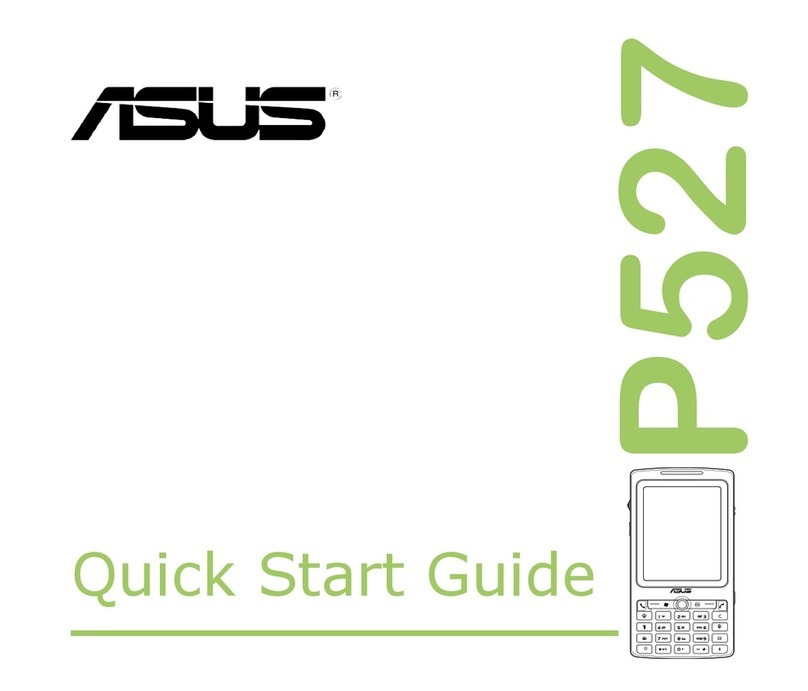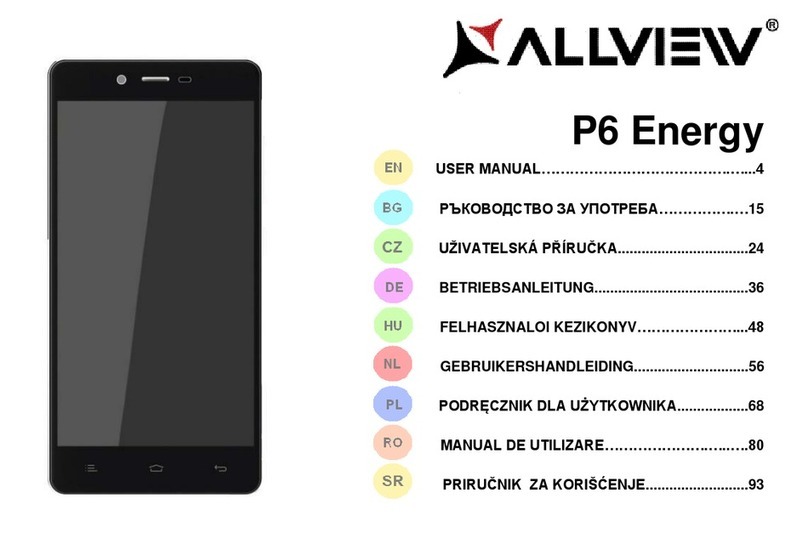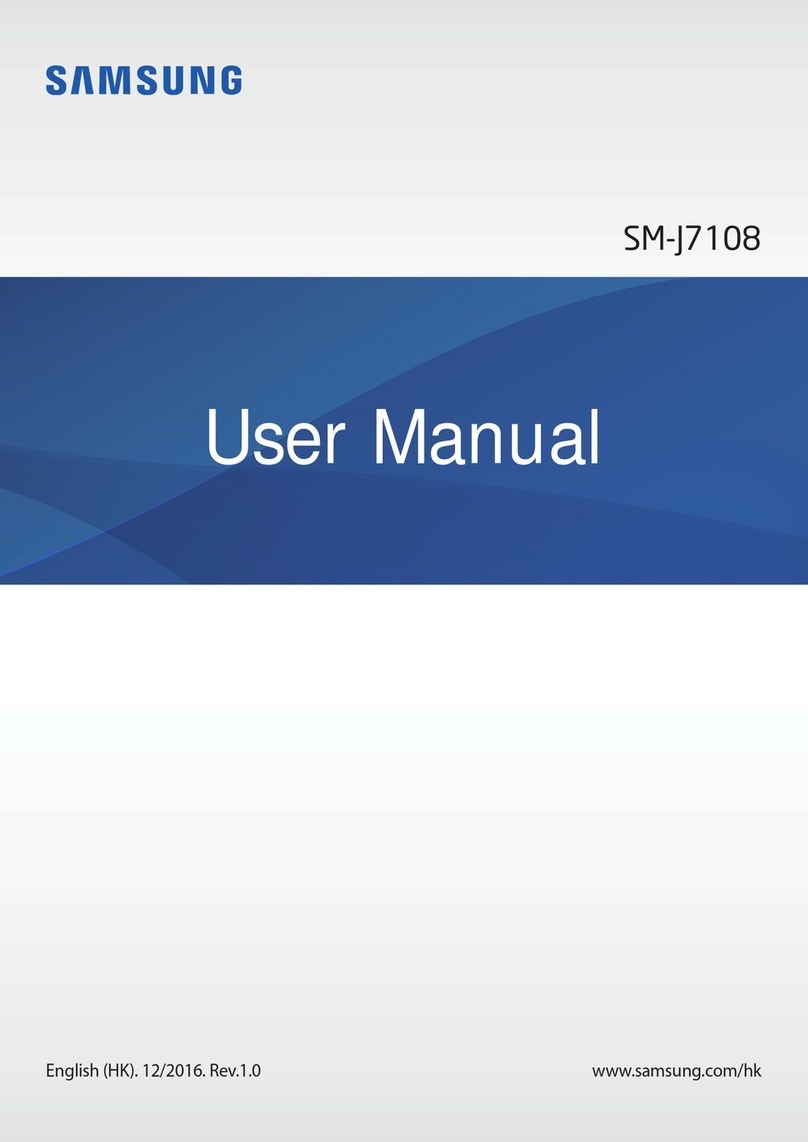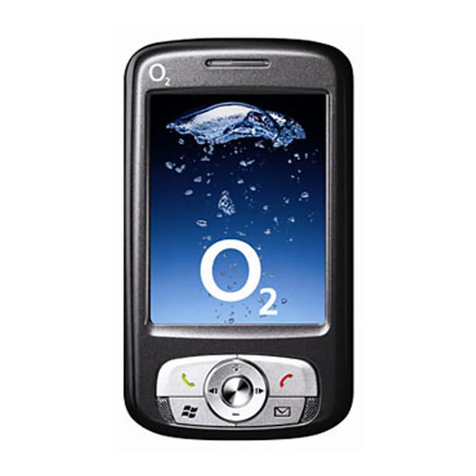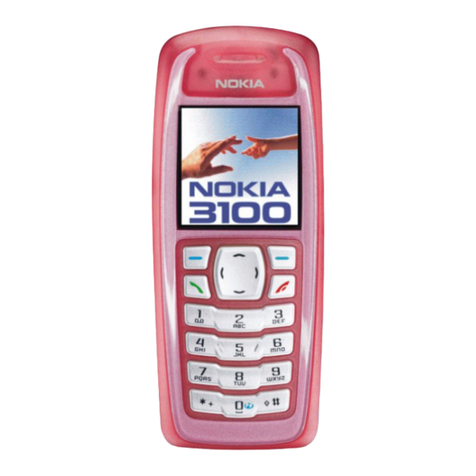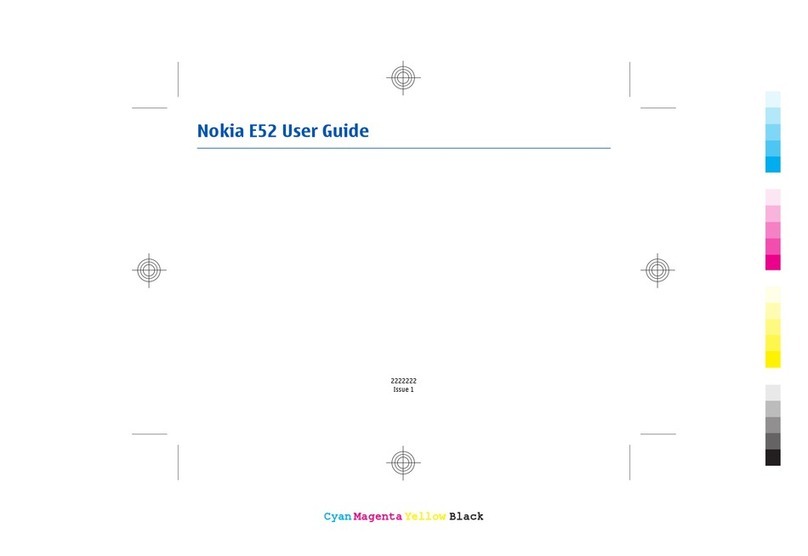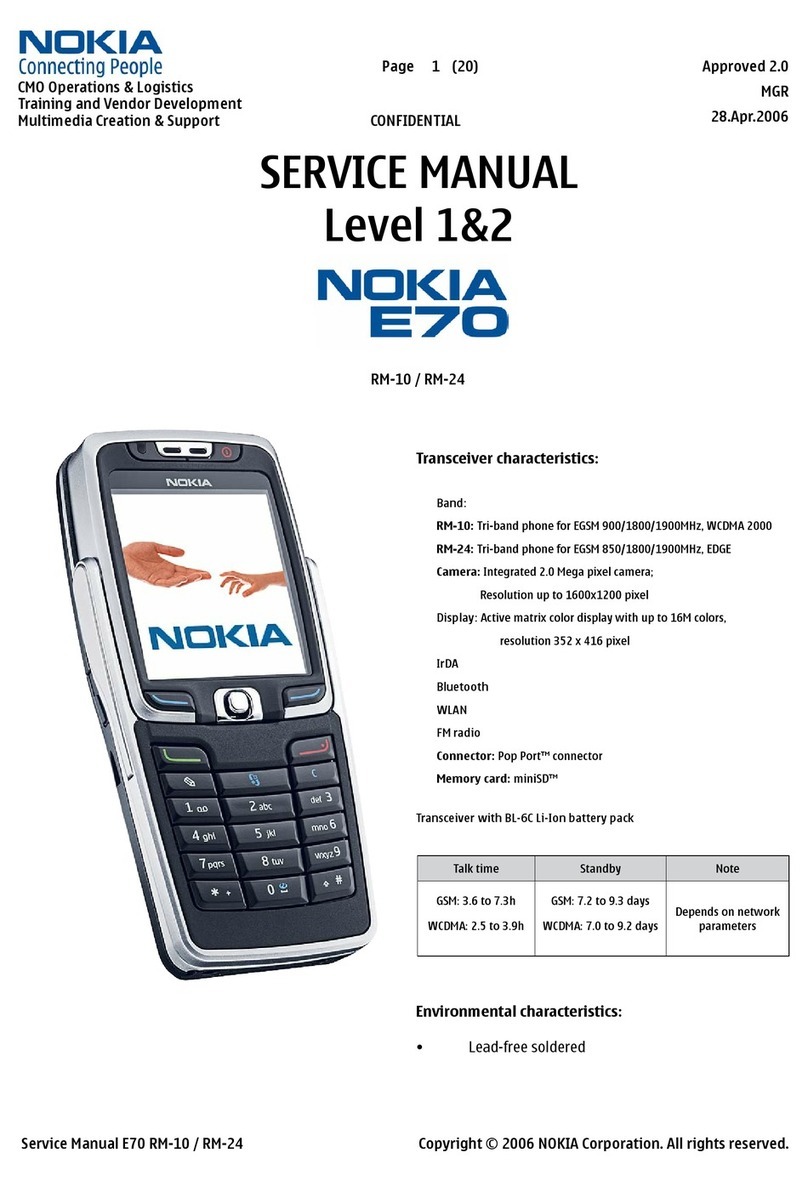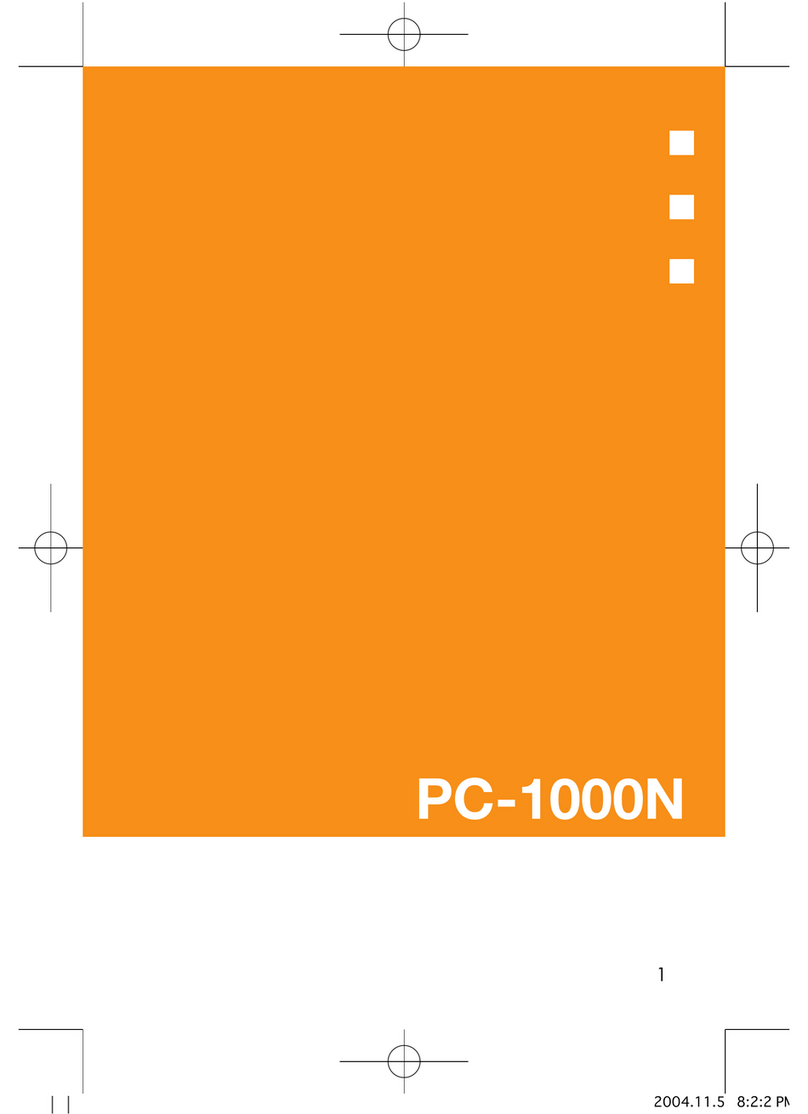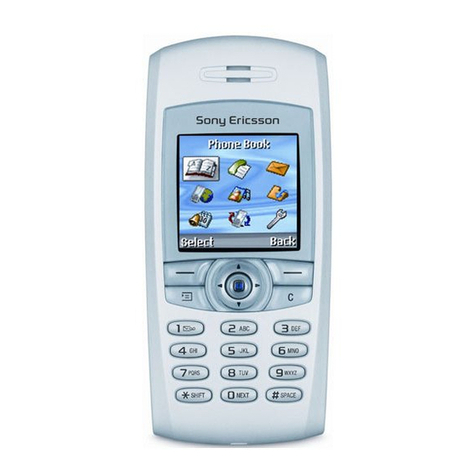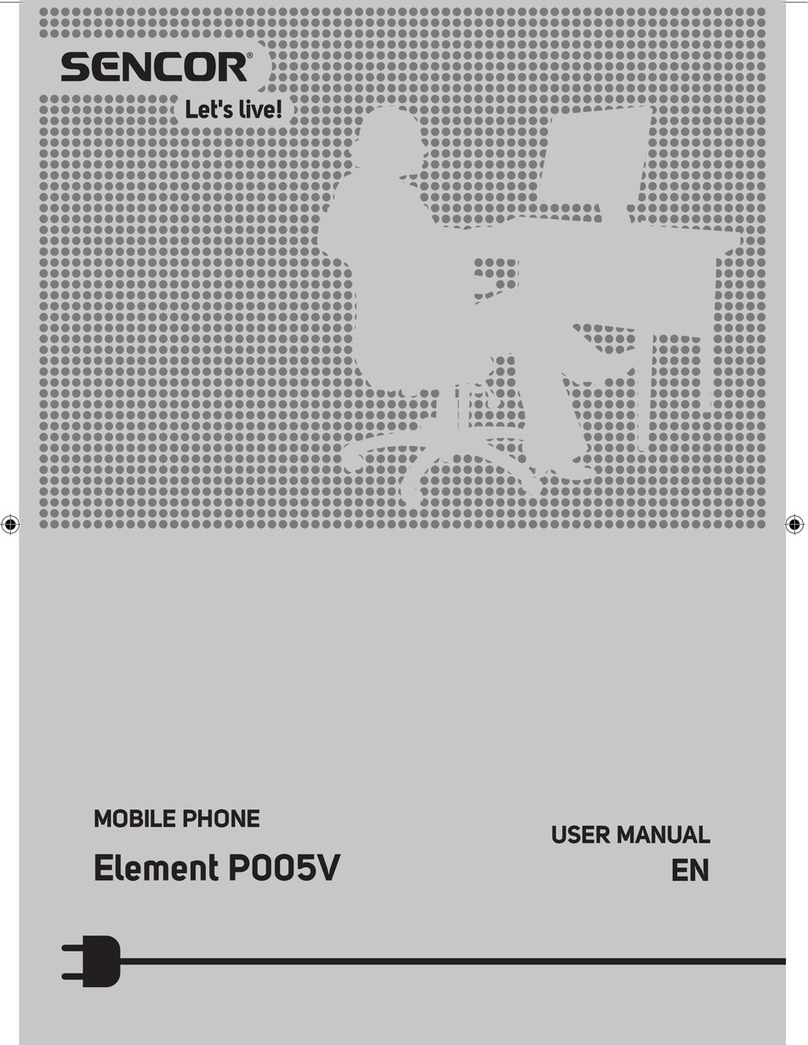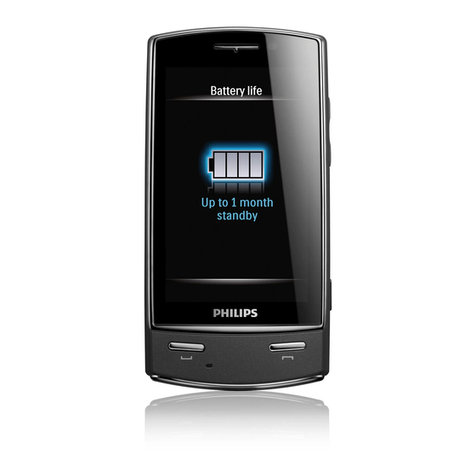Telular TG-1 Express User manual

56044702 i © 2012 Telular Corporation
InstallationGuide
TG-1
Express
June 21, 2012
COMPANY CONFIDENTIAL
For use by TELGUARD
®
customers only.
Distribution to other parties strictly prohibited.

56044702 ii © 2012 Telular Corporation
Important Note
The registration form must be completed before leaving for the job
site to install the Telguard product. There are two ways to register a
Telguard unit:
register online at www.telguardonline.com, or
submit the online registration form at www.telguard.com,
Foreword
The Telguard model TG-1 Express cellular alarm communicator is UL
Listed for Household Fire systems and Household Burglary systems. This
means that the TG-1 Express may be used in Household Burglary
systems, Household Fire systems or combined Household Burglary &
Fire system as the primary communication path.
Technical Support
Technical support for all Telguard products is available Monday through
Saturday.
Toll Free: 800-229-2326, option 9
Monday -Saturday 8am -8pm EST

56044702 iii © 2012 Telular Corporation
About this Manual
This manual assumes that you have basic security system installation
skills such as measuring voltages, stripping wire, properly connecting
wires together, connecting wires to terminals, and checking phone lines.
It also assumes that you have a familiarity with the proper installation
and programming tasks related to various alarm panels.
The material and instructions covered in this manual have been carefully
checked for accuracy and are presumed to be reliable. However, Telular
assumes no responsibility for inaccuracies and reserves the right to
modify and revise this manual without notice.
It is our goal at Telular to always supply accurate and reliable
documentation. If a discrepancy is found in this documentation, please
mail or fax a photocopy of the corrected material to:
Telular Corporation
Telguard Technical Support
2727 Paces Ferry Road SE
Suite 1-800
Atlanta, GA USA 30339
Fax: 678-945-1651

56044702 iv © 2012 Telular Corporation
Repair and Warranty
If issues are experienced with the Telguard
Cellular Alarm Transmission
System please contact Telguard Technical Support for troubleshooting.
Repair of this equipment should only be referred to Telular.
Telular will repair or replace (our option) inoperative units for up to two
years from date of manufacture. This excludes damage due to lightning
or installer error. Unauthorized modifications void this warranty. Not
responsible for incidental or consequential damages. Liability is limited
to price of unit. This is the exclusive warranty and no other warranties
will be honored, whether expressed or implied.
If a Telguard unit needs to be returned for repair, please return the
product to the distributor that the unit was originally purchased from. If
you are unsure of the distributor, please contact Telular’s RMA
Department at 800-229-2326 option 1 to provide the distributor who
sold the unit. Distributor will contact Telular to determine if the product
is within the warranty period. Units without a serial number, damaged
by lightning, damaged by vandalism or show signs of tampering will not
be covered by warranty. Units returned for repair that are out of the
warranty period or do not meet warranty criteria will be subject to a
minimum repair charge.
An RMA must be assigned before returning product to:
Telular Corporation
Attention: Repair Depot
294 W Palatine Rd
Wheeling, IL 60090
RMA number must be on outside of box or product will not be
accepted.

56044702 v © 2012 Telular Corporation
Future Testing and Limitations on Use
Telguardis part of an advanced design alarm-communication system.
It does not offer guaranteed protection against burglary and fire. Any
alarm communication system is subject to compromise or failure.
The Telguardwill not work without power. Electrically powered devices
will not work if the power supply is off for any reason, however briefly.
The cellular radio network, needed to transmit alarm signals from
protected premises to a central monitoring station, may be inoperable
or temporarily out of service. Cellular radio networks are also subject to
compromise by sophisticated methods of attack.
This equipment, like any other electrical device, is subject to component
failure. Although this equipment is designed to be long lasting, the
electrical components could fail at any time.
Due to these limitations, we recommend that if the automatic self-test
feature is not enabled, other arrangements be made with the user to
test the system at least once every three months. Moreover,
arrangements should also be made for on-site inspection/test by a
licensed alarm installer at least once each year.

56044702 vi © 2012 Telular Corporation
Terms and Conditions for Use of Telular Product
These Terms and Conditions are a legal contract between you and
Telular Corporation for the title to and use of the Product. BY
RETAINING AND USING THE PRODUCT YOU AGREE TO THE TERMS
AND CONDITIONS INCLUDING WARRANTY DISCLAIMERS, LIMITATIONS
OF LIABILITY AND INDEMNIFICATION PROVISIONS BELOW. IF YOU DO
NOT AGREE TO THE TERMS AND CONDITIONS, DO NOT USE THE
PRODUCT AND IMMEDIATELY RETURN THE UNUSED PRODUCT FOR A
COMPLETE REFUND. You agree to accept sole responsibility for any
misuse of the Product by you; and, in addition, any negligent or illegal
act or omission of your or your agents, contractors, servants, employees,
or other users of the Product so long as the Product was obtained from
you, in the use and operation of the Product.
INDEMNIFICATION OF TELULAR CORPORATION (“TELULAR”)
YOU SHALL INDEMNIFY, DEFEND AND HOLD HARMLESS TELULAR FOR
ANY OF THE COST, INCLUDING REASONABLE ATTORNEYS’ FEES, AND
FROM CLAIMS ARISING OUT OF YOU, YOUR CLIENTS’ OR OTHER THIRD
PARTIES’ USE OR OPERATION OF THE PRODUCT: (i) FOR MISUSE OR IN
A MANNER NOT CONTEMPLATED BY YOU AND TELULAR OR
INCONSISTENT WITH THE PROVISIONS OF THIS MANUAL; (ii) IN AN
ILLEGAL MANNER OR AGAINST PUBLIC POLICY; (iii) IN A MANNER
SPECIFICALLY UNAUTHORIZED IN THIS MANUAL; (iv) IN A MANNER
HARMFUL OR DANGEROUS TO THIRD PARTIES; (v) FROM CLAIMS BY
ANYONE RESPECTING PROBLEMS, ERRORS OR MISTAKES OF THE
PRODUCT; OR (vi) COMBINATION OF THE PRODUCT WITH MATERIAL,
MODIFICATION OF THE PRODUCT OR USE OF THE PRODUCT IN AN
ENVIRONMENT NOT PROVIDED, OR PERMITTED, BY TELULAR IN
WRITING. THE PARTIES SHALL GIVE EACH OTHER PROMPT NOTICE OF
ANY SUCH COST OR CLAIMS AND COOPERATE, EACH WITH THE
OTHER, TO EFFECTUATE THIS INDEMNIFICATION, DEFENSE AND HOLD
HARMLESS.

56044702 vii © 2012 Telular Corporation
WARRANTY and LIMITATIONS
TELULAR WILL REPAIR OR REPLACE (OUR OPTION) INOPERATIVE UNITS
FOR UP TO TWO YEARS FROM DATE OF MANUFACTURE. EXCLUDES
DAMAGE DUE TO LIGHTNING OR INSTALLER ERROR AS WELL AS UNITS
THAT INCORPORATE MATERIAL, OR USED IN A MANNER OR
ENVIRONMENT, NOT SPECIFICALLY AUTHORIZED IN THIS MANUAL.
UNAUTHORIZED MODIFICATIONS VOID THIS WARRANTY. NOT
RESPONSIBLE FOR INCIDENTAL OR CONSEQUENTIAL DAMAGES.
LIABILITY LIMITED TO PRICE OF UNIT. THIS IS THE EXCLUSIVE
WARRANTY, IN LIEU OF ALL OTHER WARRANTIES INCLUDING IMPLIED
WARRANTIES OF MERCHANTABILITY, TITLE, DELIVERY, INFRINGEMENT
OR FITNESS FOR A PARTICULAR PURPOSE AND NO OTHER
WARRANTIES WILL BE HONORED, WHETHER EXPRESSED OR IMPLIED.

56044702 viii © 2012 Telular Corporation
Table of Contents
ImportantNoteii
Forewordii
TableofContentsviii
GeneralDescriptionandOperation1
VisualTour2
TG‐1Express–FirstLook2
Features3
OperatingMode3
Panel‐SuppliedPower4
SingleLineInterfaceCable(SLIC)4
MultipleAlarmFormatSupport4
CompleteSupervisionofCommunicationPath5
TelguardAutomaticSelf‐testReport6
TelguardRemoteQueryCapability7
ProgrammableSupervisoryTripOutput(STC)Relay7
DiagnosticandStatusLEDs8
2‐WayVoice8
ULListings9
GettingReady9

56044702 ix © 2012 Telular Corporation
DealerAccountEstablishment9
SubscriberAccountRegistration10
Pre‐InstallationChecklist10
Installation11
Summary11
Step1:RegistertheTelguardUnitforService12
Step2:LocateUnitandMeasureSignalStrength(RSSI)12
Step3:Program,Activate&TransmitAlarms16
Step4:ConnecttheSupervisoryTripOutput21
Step5:ConnectandTesttheTripInput(optional)23
Step6:CompletetheTelguardInstallation25
Appendix1–ConnectionGuide26
Appendix2–TroubleshootingGuide28
Appendix3–DetailedSpecifications32
DialertoInterfaceElectronics32
PowerConsumption32
DigitalCellularRadio32
Appendix4–PartsList34

56044702 1 © 2012 Telular Corporation
General Description and Operation
The TelguardTG-1 Express is a digital cellular radio alarm
transmission device used to provide a primary transmission path
(cellular) for Household alarm panels. When transmitting an alarm
signal, the Telguard unit obtains its data from the alarm panel by way
of a telephone interface. The Telguard will obtain all alarm signal
information including monitoring station phone number, account
number and all zones for every alarm transmission. The Telguard
transmits a Link Request to the Telular Communication Center and,
when a link acknowledgement is received, the Telguard handshakes
with the alarm panel and causes it to transmit the alarm data. Telguard
encodes the alarm data and transmits it to the Telular Communication
Center over the cellular network. The Telular Communication Center
performs a function similar to a central station receiver and issues the
transmission acknowledgement when the last message in the
transmission is received. After decoding and reformatting, the alarm
signal is routed over the telco line (Public Switched Telephone Network
- PSTN) to the appropriate alarm company central station for action.
In a typical alarm installation, Telguard Digital TG-1 Express is installed
in the same area as the host alarm system and is connected directly to
the host alarm panel via the Telguard’s RJ-45 jack in the normal
fashion. One programmable System Trouble Condition (STC) relay is
available for connection to the host control/communicator's trip zone
input terminals in order to provide a Telguard trouble signal to the
alarm panel. Additionally, automatic self-test and remote query signals
are transmitted exclusively over the cellular network to the Telular
Communication Center. The TG-1 Express receives operating power
form the host alarm panel, and all cellular monitoring and supervisory
functions are built in. No extra modules are required.
The UL Listed equipment at the Telular Communication Center (TCC)
plays a key role in the operation of every Telguard. All Telguard units
are required to use the Communication Center because of the alarm
panel alarm signal format encoding and decoding requirements used
in packet-data transmissions over the digital cellular network. The

56044702 2 © 2012 Telular Corporation
Communication Center also manages the real-time databases for
cellular service and a complete history of every Telguard unit’s
operating conditions. These conditions include programming setup
information, alarm transmission information, supervisory trouble
information, status information, and automatic self-test information.
Visual Tour
TG-1 Express – First Look

56044702 3 © 2012 Telular Corporation
Inside the TG-1 Express
Features
This section summarizes the key features of the Telguard TG-1 Express.
Operating Mode
The Telguard Digital TG-1 Express is a digital cellular transmission
device that is installed at the protected premises to provide primary
alarm transmission integrity for household burglary and fire systems.

56044702 4 © 2012 Telular Corporation
Panel-Supplied Power
The Telguard TG-1 Express has an extremely low power profile, and as
such can usually be powered from the panel to which it is connected.
At 45mA (average consumption WHILE IDLE), the power required by
the TG-1 Express is about the same as that is used by many keypads.
Simply connect the Auxiliary power output from any voltage
compatible (6.2V to 17V) panel to the DC input on the TG-1Express.
Using the panel to provide power for the TG-1 Express allows for a
simpler installation, and eliminates the need for additional A/C outlets.
The installer shall verify that the control unit's alarm current is not
exceeded when a bell and the TG-1 Express are simultaneously
connected. For panels with very limited power capabilities, a Telguard
TG-1 or TG-4 communicator should be used, both of which utilize a
battery backed-up A/C power source, separate from the panel.
Single Line Interface Cable (SLIC)
To further simplify installation, the TG-1 Express can be connected to
the panel power using pins 2 and 7 of the RJ-45 connector for Ground
and Power respectively. This allows the installer to connect both the
communication path as well as the power to the alarm panel using a
single cable.
Multiple Alarm Format Support
The default program setting of the Telguard TG-1 Express is for Auto
Detection of the panel alarm format. The Auto Format Detect feature
allows the Telguard to adapt to receive any listed format on every
alarm transmission. If the alarm format is changed for whatever
reason, the Telguard will sense the new format and accept the alarm
signal.
In order for the host alarm panel to be compatible with the Telguard,
the panel must be programmed to transmit alarm messages to the
central station using one of the following non-extended formats:

56044702 5 © 2012 Telular Corporation
Pulse Formats:
o3+1 pulse; 10pps, Double Round, 1400Hz ack
o3+1 pulse; 20pps, Double Round, 2300Hz ack
o3+1 pulse; 40pps, Double Round, 2300Hz ack
o4+2 pulse; 10pps, Double Round, 1400Hz ack
o4+2 pulse; 20pps, Double Round, 2300Hz ack
o4+2 pulse; 40pps, Double Round, 2300Hz ack
Contact ID
Modem IIe or IIIa2
SIA2 (SIA-DC-03 level 2 release at 300 baud)
DMP
Hexadecimal account numbers can be used with 3+1 or 4+2
formats, as well as Contact ID (4 or 10 digits) and Modem IIe
or IIIa2(4 digits).
Complete Supervision of Communication Path
The Telguard TG-1 Express continuously supervises the primary
(cellular) communication path. If the cellular communications path
becomes inoperative, the TG-1 Express generates a relay trip output
that can be connected to a zone input of the host alarm panel and/or
used to activate remote annunciation devices.
No Service Condition (NSC)
The Telguard declares a no service condition (NSC) when 1 of the
following occurs.
- The Telguard device is unable to register with the cellular network.
- The Telguard device has registered with the cellular network and the
measured “receive” cellular radio signal strength at the protected
premises drops to -114 dBm or less.
NSC is programmable to trip the supervisory relay output (STC relay)
after a variable period of time. The STC LED will flash 4 times
immediately after losing cellular. NSC restoral occurs immediately after
cellular service has been acquired.

56044702 6 © 2012 Telular Corporation
Radio Failure Condition (RFC)
Radio communications failure condition (RFC) is declared when
Telguard is unable to transmit over the cellular network even with
acceptable signal strength. RFC is indicated by the STC LED flashing 5
times. RFC is cleared automatically after 10 minutes.
Panel Presence Failure Condition (PPFC)
Panel presence failure condition (PPFC) is declared when the Telguard
is unable to detect the presence of the host alarm panel. PPFC is
indicated by the STC LED flashing 7 times. PPFC is restored
immediately after the connection to the panel is restored and
maintained for the delay period.
Dial Tone Failure (DTF)
The Telguard continuously monitors the 30V supply circuit that
provides dial tone to the alarm panel. A Dial Tone Failure (DTF) is
declared when the 30V supply drops to 20V or less while the alarm
panel is on-hook. The STC LED will flash 6 times and the STC relay will
trip. This condition requires contacting Technical Support for
resolution.
Catastrophic Failure (CF)
Catastrophic Failure (CF) is any condition that causes the Telguard to
stop functioning at all levels, most commonly because of power failure.
The STC trip output is activated and visible indication is loss of all LED
activity. If power is connected properly to the unit when a CF occurs,
please contact Telguard Technical Support for resolution.
Telguard Automatic Self-test Report
The Telguard automatic self-test signal is programmed to daily, weekly
or monthly schedule as prescribed by contract. The central station
receives the automatic self-test report in the same format that the

56044702 7 © 2012 Telular Corporation
alarm panel normally uses for communication over the telco line. The
self-test code and testing frequency are set during registration, and
can accommodate any code the Central Station expects. The TCC
captures all current and historical data pertaining to the operation of
the Telguard when it processes the automatic self-test signal. This data
contains current operational status (C.O.S.) of the Telguard such as "All
OK", current trip input status, or any combination of the system trouble
conditions, as well as the current signal strength. In addition, the data
also contains historical data for supervisory events that occurred since
the last self-test signal was transmitted. This data includes the number
of occurrences of communications failure conditions and no cellular
service conditions. This additional information is available by
contacting Telular Technical Support or by visiting
www.TelguardOnline.com (dealer log-in credentials required).
Telguard Remote Query Capability
Although Telguard has the capability for a daily, weekly, or monthly
automatic self-test, a separate feature is provided for determining the
current operational status of every Telguard. This feature is called
Remote Query and is used to provide real-time operational status for
Telguard on-demand. It is useful in resolving STC events that are
reported by the alarm panel to the central station. Authorized
personnel can initiate the Remote Query at any time by calling
Customer Service or by visiting www.TelguardOnline.com. The Remote
Query causes Telguard to upload current operational status data and
historical data, just as the automatic self-test described above, except
that the query signal is controlled by the one who initiates it. The
query signal is held in the Telguard database at the Communication
Center for review and is not forwarded on to the central station.
Programmable Supervisory Trip Output (STC) Relay
The Telguard Digital TG-1 Express has one supervisory relay trip output
(STC) and is energized in a powered-up state when no system troubles
exist. It enables a supervisory trouble code to be transmitted to the
central station when connected to an alarm panel’s 24-hour instant

56044702 8 © 2012 Telular Corporation
input zone. The STC relay is programmable, using a standard touch-
tone telephone or butt-set, to meet virtually any installation
requirement.
The following supervisory features or combination of features are
programmable to trip the STC relay in order to meet a variety of
installation requirements:
Trips on no service condition (NSC).
Trips on radio communication failure condition (RFC).
Trips on low power failure (LPF).
Trips on dial tone failure (DTF).
The following system trouble features are embedded in the Telguard
for tripping the STC relay and cannot be changed:
Tripped when unit is not activated at the Telular
Communications Center (TCC)
Trips on catastrophic failure (CF) if all power is lost.
Trips on transmit-disable command from the Communication
Center. This radio command disables only the Telguard
transmitter and would be used, for example, to shut down the
Telguard due to a runaway panel dialer.
Diagnostic and Status LEDs
Seven LEDs are provided as a useful aid during installation and give
installers an immediate visual indication of system status. The LEDs
serve as indicators for activation, system trouble conditions, and
communication indicators. They also can be used to provide a signal
strength indication, similar to the signal strength bars on a cellular
phone. See the installation section for details.
2-Way Voice
TG-1Express supports 2-Way Voice feature when installed with a
control panel that is UL Listed for this feature.

56044702 9 © 2012 Telular Corporation
Note: Currently, the two-way voice feature is available solely for panels
configured for Contact ID.
UL Listings
Model TG-1 Express meets the requirements for all Household
Burglary, Household Fire, and Combined Household Burglary/Fire
installations. It has a plastic enclosure and dipole antenna. TG-1 Express
is UL and ULC Listed for the following:
UL Household Burglary (UL 1023)
UL Household Fire (UL 985)
ULC Household Burg (C1023)
ULC Household Fire (S545)
Getting Ready
The Telguard can only be activated when all the necessary accounting
information has been entered into the customer database located at
the Telular Communication Center. The database includes information
about the customer account, unit location, and system test plan
information.
Dealer Account Establishment
Prior to registration of any Telguard unit, a Dealer Account must be
established. Once the Dealer Account has been submitted and
approved by Telular, a Telguard online service registration form may be
submitted. Establish your Dealer Account by completing the Online
Telular Cellular Service Dealer Account Application at
www.telguardonline.com. Once the application has been completed
you will receive an acknowledgment within 1 business day or sooner.
This is a one-time event; the acknowledgment from the Telular
Customer Service will include a Dealer Account Number that will be
used for all Telguard registrations.

56044702 10 © 2012 Telular Corporation
Subscriber Account Registration
A completed Registration Form is required by Telular to register the
Telguard unit prior to leaving for the job site. Service registration of
the Telguard can be accomplished:
Online – Complete the Registration Form online at
www.telguardonline.com
Email - Send the Electronic Registration Form at
www.telguard.com
Service registration occurs immediately 24/7 using TelguardOnline.
Email takes 30 minutes after receipt of the registration form during
Telguard business hours.
The subscriber record is created and the Telguard device will be
ready for activation. Activation occurs automatically upon
transmission of the first alarm signal.
Pre-Installation Checklist
Before attempting to connect Telguard to the host alarm panel, please
note the following:
Be sure you have all the proper parts before you go to the job site. The
following items are shipped with each Telguard unit:
Basic TG-1 Express unit, with antenna.
TG-1 Express Installation Guide.
Quick Install Guide
Interactive Services Quick Wiring Guide
You must also have certain installation test tools:
A standard telephone or lineman's butt-set is required at the
job site for use in programming the unit.

56044702 11 © 2012 Telular Corporation
Screws and a screwdriver will be required to attach the unit
and antenna to the wall.
In order to connect the STC relay output to the alarm panel,
stranded electrical wire will be required. The terminal strips
can accommodate solid or stranded wire sizes from 14 to 22
gauge.
A standard RJ31X-to-spaded leads cable will be required to
connect the TG-1 Express to the panel. These are usually
supplied with the alarm panel.
Note: Your unit may be subject to airtime charges for unintended use.
Telular Cellular Service offers several cellular service rate plans.
Installation
Summary
There are six steps in installing Telguard properly. IF YOU DO NOT
PROCEED IN THE ORDER AND MANNER PRESCRIBED, YOU MAY NOT
COMPLETE THE INSTALLATION IN THE TIME ALLOCATED. These six
steps are summarized below and then explained in detail in the
remainder of this manual.
1. Register for Telguard service
2. Locate Unit and measure signal strength
3. Program, activate and transmit alarm panel alarms
4. Connect supervisory trip outputs
5. Connect trip input (optional)
6. Complete installation
This six-step installation approach provides the alarm installer with the
easiest and fastest method of properly installing Telguard. Please
follow the instructions carefully and if you should need assistance or
have any questions, call Telguard TECHNICAL SERVICE at 1-800-229-
2326 option 9.
Other manuals for TG-1 Express
1
Table of contents
Other Telular Cell Phone manuals
